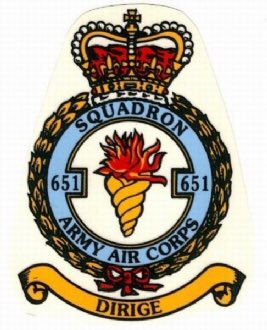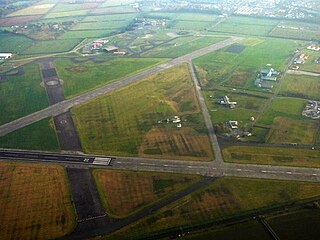
The Army Air Corps (AAC) is the aviation arm of the British Army, first formed in 1942 during the Second World War by grouping the various airborne units of the British Army. Today, there are eight regiments of the AAC, as well as two independent flights and two independent squadrons deployed in support of British Army operations around the world. Regiments and flights are located in the United Kingdom, Kenya, and Canada. Some AAC squadrons provide the air assault elements of 16 Air Assault Brigade, through Joint Helicopter Command.

The EurocopterAS365 Dauphin (Dolphin), also formerly known as the Aérospatiale SA 365 Dauphin 2, is a medium-weight multipurpose twin-engine helicopter produced by Airbus Helicopters. It was originally developed and manufactured by French firm Aérospatiale, which was merged into the multinational Eurocopter company during the 1990s, and since 2014 Eurocopter was renamed Airbus Helicopters. Since entering production in 1975, the type has been in continuous production for more than 40 years, with the last delivery in 2021. The intended successor to the Dauphin is the Airbus Helicopters H160, which entered operational service in 2021.

Joint Helicopter Command Flying Station Aldergrove, also known as simply JHC FS Aldergrove, is a British military base located 4.4 miles (7.1 km) south of Antrim, Northern Ireland and 18 miles (29 km) northwest of Belfast, and adjoins Belfast International Airport. It is sometimes referred to simply as Aldergrove which is the name of a nearby hamlet.

Royal Air Force Shawbury, otherwise known as RAF Shawbury, is a Royal Air Force station near the village of Shawbury in Shropshire in the West Midlands of England.

The Defence Helicopter Flying School (DHFS) was a military flying school based at RAF Shawbury in Shropshire, England. The school, established in 1997, was a tri-service organisation and trained helicopter aircrews for all three British armed forces. It initially used the Eurocopter Squirrel HT1 and Bell Griffin HT1 helicopters, which were retained despite the introduction of the Airbus Juno HT1 and Airbus Jupiter HT1.
No. 666 Squadron AAC (V) is a former squadron of the British Army's Army Air Corps (AAC). It was previously No. 666 Squadron RAF, a unit of the Royal Air Force during the Second World War and afterwards became a Royal Auxiliary Air Force (RAuxAF) squadron between 1 May 1949 and 10 March 1957.

656 Squadron AAC is a squadron of the British Army's Army Air Corps. It was chosen as one of the AAC new AgustaWestland Apache squadrons and in April 2004 started its conversion to role. The first phase of this completed in October 2004. The squadron was the first operational Apache squadron in the Army Air Corps and was awarded fully operational status along with the remainder of 9 Regiment AAC in June 2005. It is under 4 Regiment AAC as of 2007.

The Joint Special Forces Aviation Wing (JSFAW) is a Royal Air Force (RAF) and British Army joint service organisation that coordinates the provision of aviation support to the United Kingdom Special Forces.

Stirling Lines is a British Army garrison in Credenhill, Herefordshire; the headquarters of the 22 Special Air Service Regiment and the Special Reconnaissance Regiment (SRR). The site was formerly a Royal Air Force (RAF) non-flying station for training schools, known as RAF Credenhill.

No. 651 Squadron Army Air Corps, is an aircraft squadron of the British Army, originally formed as No. 651 Squadron Royal Air Force in Italy and North Africa during the Second World War, and afterwards in Egypt. Numbers 651 to 663 Squadrons of the RAF were air observation post units which had both Army and RAF personnel. The pilots, drivers and signallers were in the Royal Artillery whilst the adjutants, technical staff and equipment officers came from the RAF. Air observation posts were used primarily for artillery spotting, but occasionally for liaison and other duties. Their duties and squadron numbers were transferred to the Army with the formation of the Army Air Corps on 1 September 1957.

Netheravon Airfield is a Ministry of Defence grass strip airfield on Salisbury Plain, in Wiltshire, England. Established in 1913 by the Royal Flying Corps, it became RAF Netheravon from 1918 until 1963, then AAC Netheravon until 2012. Buildings from 1913 and 1914 survive on part of the site. The site forms part of the Tidworth, Netheravon and Bulford (TidNBul) Garrison.

Royal Air Force Ballykelly, or more simply RAF Ballykelly, is a former Royal Air Force station which opened in 1941 in Ballykelly, County Londonderry. It closed in 1971 when the site was handed over to the British Army as Shackleton Barracks. A small part of the base has been used as a refuelling point by army helicopters and small fixed-wing aircraft usually operating out of Joint Helicopter Command Flying Station Aldergrove near the town of Antrim.
No. 679 Squadron AAC is a British Army Reserve helicopter support squadron and is part of the 6 Regiment Army Air Corps. The squadron provides groundcrews to support Apache AH1 helicopters.

3 RegimentArmy Air Corps is a regiment of the British Army and is under the command of the 1st Aviation Brigade Combat Team within Joint Helicopter Command (JHC). The regiment operates the AH-64E Apache attack helicopter, and is based out of Wattisham Flying Station.

No. 657 Squadron AAC was a squadron of the British Army's Army Air Corps (AAC), part of the Joint Special Forces Aviation Wing based at RAF Odiham. The squadron disbanded in May 2018 after the retirement of the Westland Lynx.
No. 660 Squadron AAC is a squadron of the British Army's Army Air Corps (AAC). It was formerly No. 660 Squadron RAF, a Royal Air Force air observation post squadron associated with the 21st Army Group during the Second World War. Numbers 651 to 663 Squadrons of the RAF were air observation post units working closely with British Army units in artillery spotting and liaison. A further three of these squadrons, 664–666, were manned with Canadian personnel. Their duties and squadron numbers were transferred to the Army with the formation of the Army Air Corps on 1 September 1957.
5 Regiment Army Air Corps is a regiment of the British Army and is part of the Joint Helicopter Command (JHC). The regiment is based in Northern Ireland at JHC Flying Station Aldergrove.
7 (Training) Regiment Army Air Corps is a regiment of the British Army and is part of the Joint Helicopter Command. The regiment is responsible for providing all of the flight training of Army Air Corps (AAC) pilots. The regiment is based at the Army Aviation Centre at Middle Wallop.
No. 670 Squadron AAC is a squadron of the British Army's Army Air Corps. It is responsible for the Operational Conversion Phase of the Army Pilots’ Course. The Squadron is based at RAF Shawbury.















